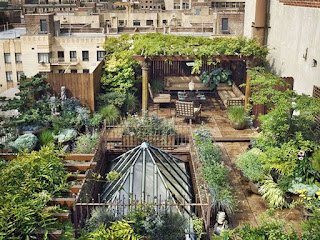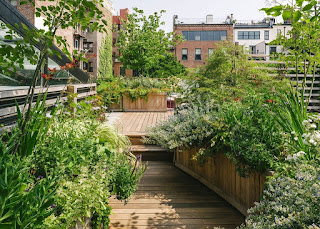Hundreds of years ago, simple huts were made with grasses and plants built into the thatched roofs, which grew to keep the house insulated and guarded from outside forces. At the present time, this antiquated idea of a roof garden has changed into the modern practice of installing and growing numerous kinds of plant life in many different forms on top of homes, cottages, sheds and other adjoining buildings. From elaborate, decorative gardens to simple, practical mats, these new structures (and the know-how that makes them possible) are spreading rapidly across the country.
Roof gardens that are more lavish can be soothing getaways that offer solitude to homeowners who want to install a private garden entirely under their care. These functional varieties of roof garden, harboring mostly grasses and herbs, act as an extra layer of protection, keeping your residence warm during the winter and cool during the summer. Rainwater that falls on these roofs is collected and used within the garden. By the quantity of sunlight and weather damage that the garden takes, you can double your roof’s lifespan by adding a roof garden.
The Environmental Protection Agency (EPA) has been encouraging urban areas to develop roof gardens for years, citing the numerous environmental benefits to keeping growing roofs wherever feasible. In seriously urbanized areas, roof gardens cleanse the surrounding atmosphere of harmful air contaminants, not to mention switching carbon dioxide for oxygen.
Roof gardens can have many different levels of maintenance, depending on how complicated they are and how much space they cover. In rural areas, side roofs, such as sheds, greenhouses and garages, are often the best places for roof gardens because they are predisposed to be flatter and easier to install on than main roofs. For simpler roof gardens, you can acquire installation packages that will set up the roof garden on either flat or sloping surfaces.
When building rooftop gardens that are more complex, one includes many types of plants, bushes, and flowers, homeowners should be sure the roof can hold the extra weight and has been waterproofed with a film that includes the right, ecologically healthy soil substitute. A well-designed intensive roof garden will create a mini-ecological environment including a wide assortment of native plants that can encourage wildlife and help sustain each other in a continuing cycle.
Although roof gardens can provide copious benefits, many people are unsure how to construct one. Unless homeowners purchase an assembly kit, they may be lost when it comes to choosing the right roof foliage for their needs and climate.
Those wanting only a simple green roof should think about grasses, sedum and mosses, which are adequate and take very little trouble to grow. For gardens that are more intricate, choose native plants, well-established specimens that will be able to survive your area’s weather conditions on rooftops. You can add more seeds or plants as needed. Homeowners should take advantage of current roof projects and began planning a roof garden today!
Roof gardens that are more lavish can be soothing getaways that offer solitude to homeowners who want to install a private garden entirely under their care. These functional varieties of roof garden, harboring mostly grasses and herbs, act as an extra layer of protection, keeping your residence warm during the winter and cool during the summer. Rainwater that falls on these roofs is collected and used within the garden. By the quantity of sunlight and weather damage that the garden takes, you can double your roof’s lifespan by adding a roof garden.
The Environmental Protection Agency (EPA) has been encouraging urban areas to develop roof gardens for years, citing the numerous environmental benefits to keeping growing roofs wherever feasible. In seriously urbanized areas, roof gardens cleanse the surrounding atmosphere of harmful air contaminants, not to mention switching carbon dioxide for oxygen.
Roof gardens can have many different levels of maintenance, depending on how complicated they are and how much space they cover. In rural areas, side roofs, such as sheds, greenhouses and garages, are often the best places for roof gardens because they are predisposed to be flatter and easier to install on than main roofs. For simpler roof gardens, you can acquire installation packages that will set up the roof garden on either flat or sloping surfaces.
When building rooftop gardens that are more complex, one includes many types of plants, bushes, and flowers, homeowners should be sure the roof can hold the extra weight and has been waterproofed with a film that includes the right, ecologically healthy soil substitute. A well-designed intensive roof garden will create a mini-ecological environment including a wide assortment of native plants that can encourage wildlife and help sustain each other in a continuing cycle.
Although roof gardens can provide copious benefits, many people are unsure how to construct one. Unless homeowners purchase an assembly kit, they may be lost when it comes to choosing the right roof foliage for their needs and climate.
Those wanting only a simple green roof should think about grasses, sedum and mosses, which are adequate and take very little trouble to grow. For gardens that are more intricate, choose native plants, well-established specimens that will be able to survive your area’s weather conditions on rooftops. You can add more seeds or plants as needed. Homeowners should take advantage of current roof projects and began planning a roof garden today!


































Komentar
Posting Komentar